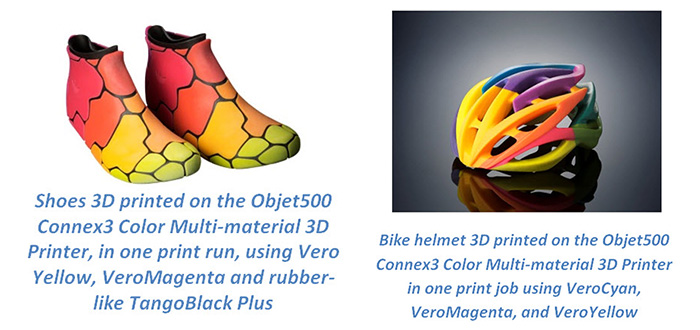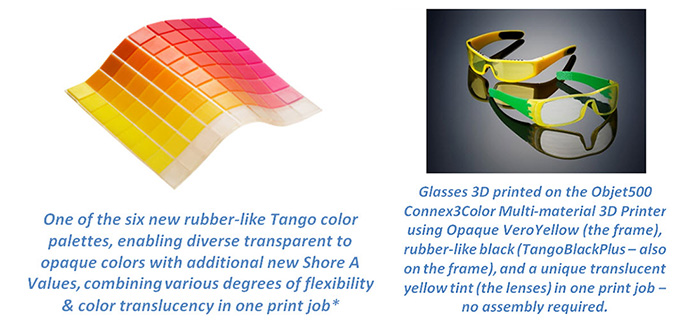Stratasys, who since it acquired Makerbot last year, has allowed its independent subsidiary to have its head; which is probably why the new Makerbot line-up of prosumer/consumer 3D printers took priority at CES, unencumbered by the industrial developments of the 3D printing giant. These developments are being revealed a fortnight later, a few hundred miles South at Solidworks World in San Diego where Stratasys has taken the covers of what we all knew was coming — multi-colour, multi-material 3D printing.
The Objet Connex platform has led the way, and still dominates when it comes to multi-material 3D printing. First introduced back in 2007, the Connex is a serious 3D printer for industrial applications and has been successfully put through its paces for some staggering applications involving multi-materials, including the work of Jason Lopes at Legacy Effects and Gary Miller at IPF in the UK. Not surprisingly then, these two have been beta testing the new Objet500 Connex3 platform for Stratasys that now brings multi-colour into the mix. On home territory, in California, Jason is talking the talk at SolidWorks World.
The work of Neri Oxman, another Stratasys favourite, when she presented her “Imaginary Beings – Mythologies of the Not Yet” exhibition in Paris back in 2012, was the first indication that the Objet platforms (pre-merger with Stratasys) were experimenting with colour. It’s been a long time coming, but it’s here now, at least in its first commercial iteration.
Billed by Stratasys as “a game-changer for product design, engineering and manufacturing processes,” the new ‘Objet500 Connex3 colour multi-material 3D printer’ (we’ll go with Connex3!) has now been unveiled and features a unique triple-jetting technology that combines droplets of three base materials to produce parts with virtually unlimited combinations of rigid, flexible and transparent colour materials as well as colour digital materials – all in a single print run. The point being, and stressed by Stratasys, is that this printer offers the ability to achieve the characteristics of an assembled part — without any assembly or painting required. It’s a big time-saver and significantly reduces notoriously slow parts of the product development process.
On revealing the new machine in San Diego, Stratasys’ CEO, David Reis said: “Stratasys’ goal is to help our customers revolutionize their design and manufacturing processes. I believe our new Objet500 Connex3 Color Multi-material 3D Printer will transform the way our customers design, engineer and manufacture new products. In general and with the Connex technology in particular, we will continue to push the envelope of what’s possible in a 3D world.“
Another beta user of the Connex3 has been Trek Bicycle in Waterloo, Wisconsin, US. They have been using it for assessment and testing of accessories like bike chain stay guards and handlebar grips prior to actual production. Mike Zeigle is the manager of Trek’s prototype development group and he reports that the Connex3 has “changed the way we manufacture at Trek, augmenting our traditional, time-consuming CNC processes with fast, iterative and realistic prototyping and functional testing. Now we produce bicycle parts that look and feel like production parts. We are particularly excited about 3D printing our models directly in colour. This gives our designers the ability to graphically display colour contact pressure map data on rider contact parts like seats and grips. We are also working on doing the same with FEA & CFD stress data on structural bike components.”
The introduction of colour to the Connex3 platform is varied. For the Vero materials it is based on three primary colour materials, which, similar to a 2D inkjet printer, can be combined to create a spectrum of vibrant colours. The three new Vero colour materials are VeroCyan, VeroMagenta and VeroYellow and will join Stratasys’ extensive range of PolyJet photopolymer materials including digital materials, rigid, rubber-like, transparent, and high temperature materials to simulate standard and high temperature engineering plastics. However, the Connex 3 also features six palettes for new rubber-like Tango colours, ranging from opaque to transparent colours in various shore values to meet the needs, as understood by Stratasys of the automotive, consumer and sporting goods and fashion industries — they’ll be commercially available in Q2 of this year I believe.
I’m looking forward Iris van Herpen’s new collection though and wouldn’t be at all surprised if some vibrant 3D printed colours graced the global catwalks next month as the fashion parades get underway for 2014!




